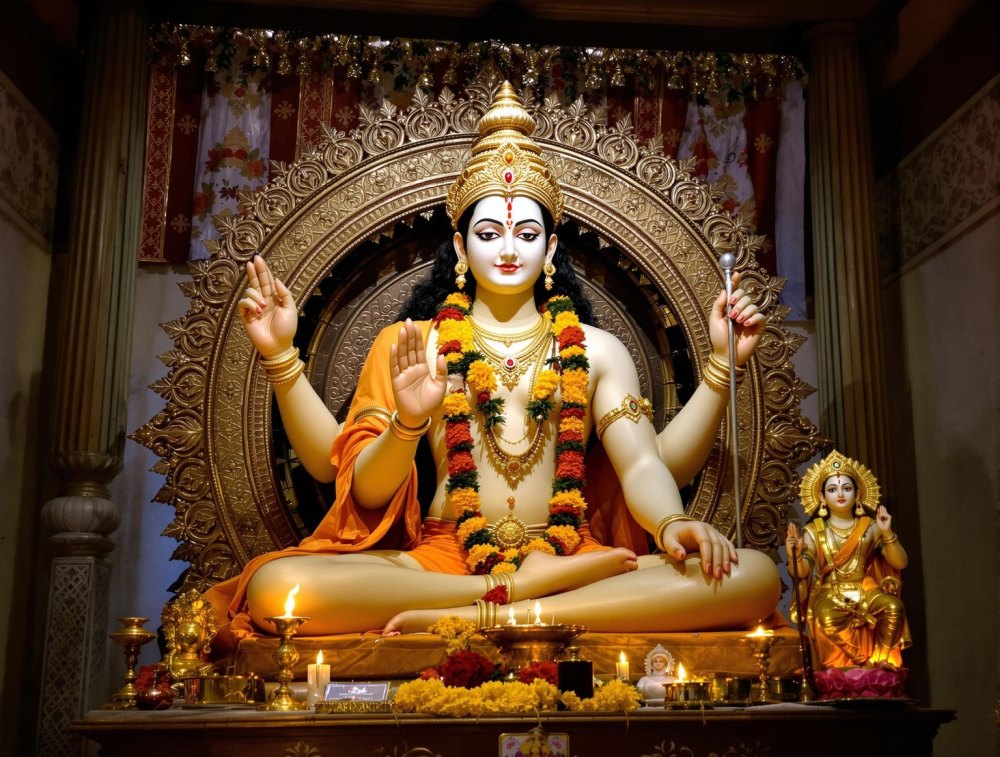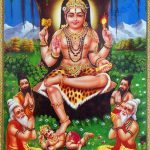Introduction to Advaita Vedanta, Non-Duality

What is Vedanta?
At its core, Vedanta is not merely a philosophy crafted by human minds. Rather, it is a timeless pramana – a means of knowledge – that reveals the king of all knowledge: self-knowledge. It challenges the notion that our identity is fixed or limited, urging us instead to question the assumptions that shape our understanding of who we are.
Many ask, “What if everything we assume about ourselves is but a thought – a limited concept?” Vedanta encourages us to explore this possibility, laying the foundation for the quest for true identity.
Human beings are the only creatures that seek to attain goals. Two things make a human being unique: self-consciousness (the knowledge ‘I am’) and free will (the faculty of choice).
The Unique Nature of Human Beings
Self-Consciousness
Self-consciousness is only partial knowledge. It becomes complete when the human being understands what I am, or who I am. Other animals are deprived of this knowledge. All other animals remain steeped in the bliss of ignorance and are thus free from neuroses, complexes, problems, and goals.
Free Will
The second unique quality is free will, or the faculty of choice. Because a human being has free will, they can choose to do something, to not do it, or to do it differently.
The Four Basic Goals of Human Life
Because of these two qualities – and because of the human being’s knowledge of values based on what is expected from others – the human being has four basic goals:
- Security (artha)
- Pleasure (kama)
- Virtue (dharma)
- Liberation (moksha)
Even though Vedantic scriptures point out the four pursuits (puruṣārthas), the ultimate endgame of each is the same: liberation from the sense of limitation.
Security, pleasure, and virtue are not really goals in and of themselves; they are means to survive, pursue happiness, and ultimately accomplish the discovery of the fullness, wholeness, completeness, peace, joy that is one’s true nature.
The Meaning of Liberation
- The word ‘puruṣārtha’ can mean ‘goal’ or ‘free will.’
- Liberation (mokṣa) is the ultimate goal toward which all actions based on free will are either consciously or unconsciously directed.
- Ironically, liberation is the choiceless human goal.
The direct meaning of the word ‘mokṣa’ is ‘freedom’; the implied meaning is ‘happiness’ or ‘fullness.’ Freedom from the unwanted (that which brings about unhappiness) is happiness.
Unhappiness is initially thought to be caused by unfulfilled desires but is eventually realized to be rooted in ignorance of one’s true nature as whole and complete, limitless, ever-present, all-pervasive, and eternally blissful awareness.
Happiness and the Self are not two different things like sun and light or fire and heat. Happiness, fullness, is the very nature (svārūpam) of the Self. Discovering who I am, therefore, is equal to discovering fullness.
Types of Happiness
There are two types of happiness:
- Pleasure based on the experience of gross and subtle objects (viṣaya ānanda)
- The bliss of the Self (ātma ānanda)
The bliss of the Self is true and permanent happiness. Whereas pleasure (experiential happiness generated by your body-mind) is merely a fraction, a taster.
External vs. Internal Sources of Happiness
- Pleasure is derived through and dependent on external objects, things, situations, and people.
- It is always time-bound and incidental because its sources are impermanent (anitya).
- Fullness is not derived from any external situation or source; it is natural happiness.
- This happiness is eternal (nitya), beyond time and space, because it is not borrowed from anything outside oneself – it is one’s own true nature.
Pleasure involves pain in its acquisition, maintenance, and loss.
In contrast, the bliss of the Self involves no pain because it is not something to be gained or attained.
As our intrinsic nature, it is already there and cannot be lost – just as the sun never loses its light or heat, so you cannot lose yourself. One’s intrinsic nature is pure happiness (kevala ānanda), unadulterated and unmixed with pain.
The Origin of Unhappiness
If pure happiness is our intrinsic nature, then why do we become unhappy? The simple answer is that our true nature is not known.
Somewhere the flow of happiness is blocked – like a tank full of water with a blocked pipe.
Śāstram explains that obstacles (pratibandhas) block the flow of happiness. Although our essential nature is fullness or happiness, it does not flow because of obstructions, hindrances, or impediments.
Types of Obstacles
There are three types of obstacles:
- Mental Impurities (malaṃ):
- The gross block.
- Mental Restlessness, Agitation, Strain, Stress, or Turbulence (vikṣepa):
- The subtle block that prevents sustained attention.
- Cover or Ignorance (āvaraṇa or ajnāna):
- The causal block that veils happiness.
The removal of these obstacles will allow one to enjoy the pure happiness that is one’s intrinsic nature.
Reducing Mental Impurities
Mental impurities can be primarily attributed to attachment (raga) and aversion (dvesha). These attachments and aversions automatically trigger desire (kama) and anger (krodha), which are the root causes of other impurities like jealousy and hatred.
Mental turbulence, the second major obstacle, is also often a consequence of mental impurities.
We cannot eliminate attachment and aversion entirely, as they are natural states of mind resulting from the interplay of the qualities (gunas) that constitute experience of living. However, if we neutralize their negative influence, or their binding aspect – other impurities are inevitably diminished.
The Path to Removing Obstacles
Removing Mental Impurities: Karma Yoga
The first obstacle – mental impurity in the form of attachments and aversions – can be neutralized through the practice of karma yoga. Karma is anything that we do physically, mentally, and orally.
Karma yoga is rooted in two fundamental understandings:
- One has the right to perform action – as long as one inhabits a body – but has no right to enjoy the fruits of such action.
- Whatever the results of one's actions, they are a gift and are ultimately in the best interest of the whole of creation.
In essence, realizing that the results of one’s actions are not under one’s control, one does what needs to be done with the best intentions and then accepts the consequences as God’s will.
This attitude defines karma yoga and transforms any action into its practice, thereby ameliorating personal preferences, eradicating the sense of personal doership, and harmonizing with the natural law (dharma) of the universe.
Removing Mental Agitation: Meditation
The second obstacle – mental agitation or restlessness – can be removed only by the practice of meditation (upāsanam).
In this context, meditation is purely a mental activity. In the Vedic culture of India, people are enjoined by the scriptures to perform specific ritualized worship (pūjā).
Although this ritual involves physical and oral activity, it is as effective as meditation when the worshiper’s focus is solely on Bhagavan or God.
Mantra repetition (japa) is also prescribed. Meditating or focusing on Bhagavan’s name is ideal; if one cannot do this, performing ritualized worship and singing devotional songs (bhajans) with focused attention on Bhagavan is a good preparation for meditation.
Even better than mantra repetition is an unbroken flow of thought resting on Bhagavan or the Self. This is essentially karma-yoga, recognizing all that is here is Ishvara, and taking to a life of devotion as described in Bhagavad Gita, Chapter 12.
Removing Ignorance: Knowledge and the Upanishads
The third obstacle – ignorance that covers happiness – is removed only after dealing with the other two obstacles. Only then will exposure to the teachings and study of the scriptures be effective.
Ignorance covers happiness like darkness covers objects in a darkened room. One may have perfect vision, but without light, nothing is seen. Similarly, ignorance conceals the Truth, making one unaware of their true nature.
The only means to remove ignorance is through knowledge (jñānam).
Knowledge does not create something new; it removes the obstacle of ignorance through this process:
- Mental impurity is removed through karma yoga.
- Mental agitation is removed through meditation (upāsanam).
- Ignorance is removed by knowledge (jñānam).
It is for the removal of ignorance that we need the Upaniṣads.
The Role of the Guru and the Upaniṣads
The Challenge of Extracting Knowledge
The Upaniṣads contain the wisdom or knowledge, yet their true meaning cannot be understood by reading alone.
Just as butter in milk does not rise to the surface without a proper method of extraction, the knowledge contained in the Upaniṣads must be extracted by a valid means.
The one who can effectively wield this means is the guru. This is why the teacher is vitally important in the Vedānta tradition.
The guru knows how to handle the words of the Upaniṣads – what to say first, what to say next – to remove any ambiguity and guide the student toward a clear understanding of the knowledge.
Structure and Purpose of the Upanishads
The Upaniṣads (jñāna khaṇḍa) are the scriptures at the end of the Veda. They are placed at the end (and throughout the Vedas) because, without first removing mental impurities and restlessness, the removal of ignorance is impossible.
Despite constituting the smallest section of the Veda, they perform the essential surgery needed to remove the cataract from the mind.
The word ‘Upanishad’ itself offers clues:
- ‘Upa’: Means ‘near’, implying a student respectfully approaching the teacher. The obstacle of ignorance needs to be dispelled, requiring the knowledge in the Upanishads, an effective method of extraction, and a teacher skilled in handling the words. Removal of ignorance is impossible without a teacher. This necessitates listening with humility and patience, without interruption or argument (shravanam).
- ‘Ni’: Stands for definite, doubt-free knowledge of what fullness, happiness, and Reality truly are. Two factors hinder doubt-free knowledge: doubt and unhealthy emotional habits. Doubt must be eliminated through reflection on what has been heard (mananam). Unhealthy thinking involves the uncontrolled proliferation of thoughts, aimless planning, and mental wandering. While natural, such mental activity obstructs the knowledge of Reality or the Self. Contemplation (nididhyasanam), or consistently reflecting on the teachings and applying them in daily life, helps to overcome unhealthy thinking. Effective contemplation requires doubt-free knowledge of Reality, which is achieved through focused listening (shravanam) and reflection (mananam).
- ‘Sad’: Means knowledge that removes ignorance and problems born from ignorance. Just as a mother instinctively knows her child's needs, the Veda understands the mind's needs. The Veda is always available to guide one to discover fullness, which is one's own nature. We already possess it, yet we search for it and suffer.
The Progression Toward Enlightenment
The progression toward enlightenment proceeds in the following way:
- Impurity (malaṃ) is removed through the practice of karma yoga.
- Mental restlessness (vikṣepa) is removed through meditation (upāsanam) and the conscious repetition of God’s name (mantra).
- Ignorance (āvaraṇa/ajnāna) is removed through knowledge (jñānam).
It is vitally important that one seeks a guru to learn how to extract this wisdom. The three elements required for effective extraction of knowledge are:
- Listening (śravaṇam):
- One must listen to the teacher, imbibing the teachings. Repeated listening leads to deeper understanding.
- Reflection (mananam):
- One must reflect upon the teachings, questioning and verifying their validity until all doubts are eradicated.
- Contemplation (nididhyāsanam):
- One must contemplate the teachings, deeply consider their meaning, and continuously apply them to one's perspective, thoughts, and actions. Even after doubts are intellectually resolved, unhealthy thought patterns may persist. Nididhyasanam helps to fully assimilate the wisdom and anchor oneself in steadfast, doubt-free knowledge, neutralizing these patterns.
Commitment to the pursuit of knowledge must be absolute. Such focus makes the study of the Upanishads effective. Understanding the value of Vedanta’s teachings and committing 100% to their study is essential.
The Limitation of Karma
Vedanta also clarifies the limitation of karma (action). Karma is important because only by performing actions can one convert them into yoga, or practice karma yoga, which is the sole method to rid oneself of mental impurity.
However, the removal of mental impurity alone does not bring fullness or liberation (moksha). It merely prepares one to assimilate the knowledge of the Self.
No new attainment occurs; one is simply removing obstacles that prevent the understanding of the Truth: first mental impurity, then mental restlessness, and finally ignorance.
Once these three obstacles are removed, one discovers what has always been present. Fullness is not attained or gained – it is recognized.
The Ultimate Value of Knowledge
The Upanishads make one realize the value of knowledge and the limitations of karma.
Karma performed without understanding its true goal leaves one bound forever; karma performed with the knowledge of its limitations becomes a yoga (spiritual practice) that removes mental impurities.
However, karma alone cannot produce self-realization. Only knowledge (jñānam) liberates.
The Upanishads speak of karma only to point out its limitation and to underscore the true role it plays in preparing the mind to understand the liberating knowledge that sets one free.





